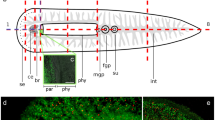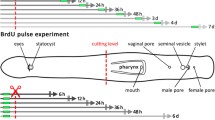Summary
Regeneration by anterior and posterior substrates (having a single transection each), indicated presence along anteroposterior axis of three morphogenetic regions. (1) A region of unipotential capacity from 16/17 anteriorly, in which all morphologically determined regenerates were cephalic, with a section from 6/7 anteriorly in which regeneration was obtained only anteriorly. (2) A region of bipotential capacity in which morphologically determined regenerates were cephalic or caudal. Apparent directional limitations of bipotentiality enabled recognition of three sections: 17/18 to 22/23 (→ 27/28?) in which regenerates at anterior transections were all cephalic but at posterior transections were cephalic or caudal or cephalocaudal; a long middle section in which all anterior regenerates were cephalic and all posterior regenerates were caudal; a posterior section in which regenerates at anterior transections were cephalic or caudal or cephalocaudal but at posterior transections were all caudal, tentatively bounded by 176/177 and 200/201. (3) A region of unipotential capacity in which all morphologically determined regenerates were caudal. Experiments were not extended to permit recognition of a terminal section in which regeneration would only take place posteriorly.
The pattern of regenerative capacity thus indicated is complicated, inP. millardi, by induction of posterior heteromorphosis by a simultaneous anterior regeneration, with heteromorphic cephalic regeneration possible at least as far back as 88/89 and by various types of regulation. Induction of homomorphosis in a heteromorphic anterior regenerate. Induction of heteromorphosis in a homomorphic posterior regenerate. Induction of substrate orientation of nephridia in proximal segments of heteromorphic regenerates. Reorganization of substrate metameres into two or three segments with characteristics of regenerate metameres.
Structure of inhibited buds and cephalic monstrosities indicates brain ofP. millardi does not have an important role as an organizer in early stages of regenerative growth.
Similar content being viewed by others
References
Gates, G. E. “Further notes on regeneration in a tropical earthworm,Perionyx excavatus E. Perrier, 1872,”J. Exp. Zool., 1941,88, 161–85.
— “Regeneration in an earthworm,Eisenia fœtida (Savigny), 1826. I. Anterior regeneration,”Biol. Bull., 1949,96, 129–39.
— “Regeneration in an earthworm,Eisenia fœtida (Savigny), 1826. II. Posterior regeneration,” —, 1950,98, 36–45.
— “Regeneration in an earthworm,Eisenia fœtida (Savigny) 1826. III. Regeneration from simultaneous anterior and posterior transections.” —, 1950,99, 425–438.
Painter, B. T. “The location of factors of head regeneration in the earthworm,”Biol. Bull., 1940,78, 463–85.
Author information
Authors and Affiliations
Additional information
Communicated by Prof. B. C. Mahendra,d.sc., p.z.s., f.a.sc.
Rights and permissions
About this article
Cite this article
Gates, G.E. Regeneration in an Indian earthwormPerionyx millardi Stephenson 1915. Proc. Indian Acad. Sci. 34, 115–147 (1951). https://doi.org/10.1007/BF03051456
Received:
Issue Date:
DOI: https://doi.org/10.1007/BF03051456




